Designing a Crowd-Based Relocation System—The Case of Car-Sharing
Abstract
:1. Introduction
2. Research Background
2.1. Forms of Car-Sharing and Vehicle Supply and Demand Management
- Station-based one-way car-sharing: Similar to station-based two-way car-sharing, except that customers can return the rented vehicle to any available station [41].
- Operator-based relocation: Providers balance vehicle supply and demand by using operators (i.e., the car-sharing provider’s employees) to drive, tow, or ride-share surplus vehicles from low demand to high demand locations [44]. This approach remains reactive in directly relocating vehicles parked in a low or relatively low demand location. Further, it is considered an expensive approach because it involves high personnel costs [19,20], comes with operational challenges such as staff rebalancing [45], and is environmentally unsustainable due to the extra kilometers driven in relocating vehicles [19,23,44].
- User-based relocation: Providers motivate users (i.e., customers currently renting and using a vehicle (Note that all users are customers, but not all customers are users. Any individual with a valid car-sharing membership is a customer; a user, however, is a customer who rents a vehicle and actually uses it. Thus, our study refers to users as currently renting and driving customers, while the term customer refers to all individuals with a valid car-sharing membership)) to change their destination and return the vehicle to an under-supplied location instead of an over-supplied one [11,42]. Thus, user-based relocation depends on an ongoing rental and tries proactively to get vehicles relocated to low-demand areas before they are parked. Research confirms this approach to be less expensive than operator-based relocation [21,42]. However, implementing such an approach is currently impractical due to the challenges of communicating with users while they are driving. Therefore, informing customers of the new destination and negotiating an incentive becomes virtually impossible [25]. Further, car-sharing customers are commonly not required to designate their destination and time of arrival [26]. This makes it nearly impossible to identify users who intend to return a vehicle to an oversupplied location.
- Pricing schemes: Besides actively relocating the vehicles, service providers can balance vehicle supply and demand by developing more cost-efficient ways of manipulating vehicle distribution. Using innovative pricing schemas is one emerging approach by which companies apply fees and discounts for renting and returning vehicles in certain areas [22,23]. These price-based vehicle supply and demand management approaches try to keep the vehicle distribution balanced by preventing undesired rentals from high-demand start locations to low-demand end locations.
2.2. Crowdsourcing
3. The Design Science Research Project
4. Designing Crowd-Based Supply and Demand Management Information Systems for Car-Sharing
4.1. Design Derivation
4.1.1. Requirements
4.1.2. Framework
Crowd-based relocation is the approach by which a provider outsources vehicle relocations to its customer base (i.e., the crowd) via an open call for participation.
4.2. Design Evaluation
- TP1: Implementing a CRIS reduces the number of operator-based relocations required (R1 Reduction);
- TP2: Implementing a CRIS leads to lower costs and emissions than operator-based relocation (R2 Efficiency);
- TP3: Implementing a CRIS leads to more vehicle relocations than the “no relocation” approach (R3 Availability);
- TP4: Implementing a CRIS leads to a similar number of vehicle relocations compared to user-based and operator-based approaches (R3 Availability);
- TP5: Implementing a CRIS can be done successfully (R4 Implementable);
- TP6: Implementing a CRIS does not require the car-sharing provider to intervene in the relocation procedure (R5 Automation);
- TP7: Implementing a CRIS does not entail high implementation or maintenance costs (e.g., hardware or personnel) (R6 Inexpensive);
- TP8: Implementing a CRIS leads to an easy system for customers to use (R7 Understandable);
- TP9: Implementing a CRIS allows multiple users to accept and complete a relocation task (R7 Understandable).
4.2.1. The CRIS Framework Implementation
4.2.2. Field Test Evaluation of the Crowd-Based Relocation Approach
4.2.3. Assessing Requirements
4.3. Design Theorizing
5. Discussion
5.1. Theoretical Implications
5.2. Practical Implications
5.3. Limitations and Future Research
6. Conclusions
Author Contributions
Funding
Institutional Review Board Statement
Informed Consent Statement
Data Availability Statement
Acknowledgments
Conflicts of Interest
References
- Schmöller, S.; Bogenberger, K. Carsharing: An Overview on What We Know. In Demand for Emerging Transportation Systems: Modeling Adoption, Satisfaction, and Mobility Patterns; Elsevier: Amsterdam, The Netherlands, 2020; pp. 211–226. [Google Scholar]
- Münzel, K.; Boon, W.; Frenken, K.; Blomme, J.; van der Linden, D. Explaining Carsharing Supply across Western European Cities Explaining Carsharing Supply across Western European Cities. Int. J. Sustain. Transp. 2020, 14, 243–254. [Google Scholar] [CrossRef] [Green Version]
- Trenz, M.; Frey, A.; Veit, D. Disentangling the Facets of Sharing: A Categorization of What We Know and Don’t Know about the Sharing Economy. Internet Res. 2017, 28, 888–925. [Google Scholar] [CrossRef]
- Nijland, H.; Van Meerkerk, J.; Hoen, A. Impact of Car Sharing on Mobility and CO2 Emissions; PBL Netherlands Environmental Assessment Agency: The Hague, The Netherlands, 2015. [Google Scholar]
- Wittwer, R.; Hubrich, S. Free-Floating Carsharing Experiences in German Metropolitan Areas. In Proceedings of the Transportation Research Procedia, XIII Conference on Transport Engineering, Gijon, Spain, 6–8 June 2018; pp. 323–330. [Google Scholar]
- Amatuni, L.; Ottelin, J.; Steubing, B.; Mogollon, J.M. Does Car Sharing Reduce Greenhouse Gas Emissions? Assessing the Modal Shift and Lifetime Shift Rebound Effects from a Life Cycle Perspective. J. Clean. Prod. 2020, 266, 121869. [Google Scholar] [CrossRef]
- Hildebrandt, B.; Hanelt, A.; Nierobisch, T.; Piccinini, E.; Kolbe, L.; Nierobisch, T. The Value of IS in Business Model Innovation for Sustainable Mobility Services—The Case of Carsharing. Wirtsch. Proc. 2015, 2015, 1008–1022. [Google Scholar]
- Willing, C.; Brandt, T.; Neumann, D. Intermodal Mobility. Bus. Inf. Syst. Eng. 2017, 59, 173–179. [Google Scholar] [CrossRef]
- Hahn, R.; Ostertag, F.; Lehr, A.; Büttgen, M.; Benoit, S. ‘I like It, but I Don’t Use It’: Impact of Carsharing Business Models on Usage Intentions in the Sharing Economy. Bus. Strateg. Environ. 2020, 29, 1404–1418. [Google Scholar] [CrossRef]
- Shaheen, S.A. Innovative Mobility: Carsharing Outlook Carsharing Market Overview, Analysis, And Trends; University of California: Oakland, CA, USA, 2020. [Google Scholar]
- Wagner, S.; Willing, C.; Brandt, T.; Neumann, D. Data Analytics for Location-Based Services: Enabling User-Based Relocation of Carsharing Vehicles. In Proceedings of the International Conference on Information Systems, Fort Worth, TX, USA, 13–16 December 2015; Volume 3, pp. 279–287. [Google Scholar]
- Illgen, S.; Höck, M. Literature Review of the Vehicle Relocation Problem in One-Way Car Sharing Networks. Transp. Res. Part B 2019, 120, 193–204. [Google Scholar] [CrossRef]
- Jorge, D.; Correia, G.H.A.; Barnhart, C. Comparing Optimal Relocation Operations with Simulated Relocation Policies in One-Way Carsharing Systems. IEEE Trans. Intell. Transp. Syst. 2014, 15, 1667–1675. [Google Scholar] [CrossRef] [Green Version]
- Golalikhani, M.; Beatriz Brito Oliveira, M.; Carravilla, A.; Oliveira, J.F.; Pisinger, D. Understanding Carsharing: A Review of Managerial Practices towards Relevant Research Insights. Res. Transp. Bus. Manag. 2021, 41, 100653. [Google Scholar] [CrossRef]
- Willing, C.; Brandt, T.; Neumann, D. Sharing Is Caring-Understanding the Relationship Between the Sharing Economy and Sustainable Mobility. In Proceedings of the International Conference on Information Systems, Dublin, Ireland, 11–14 December 2016. [Google Scholar]
- Wagner, S.; Brandt, T.; Neumann, D. In Free Float: Developing Business Analytics Support for Carsharing Providers. Omega 2016, 59, 4–14. [Google Scholar] [CrossRef]
- Nair, R.; Miller-Hooks, E. Fleet Management for Vehicle Sharing Operations. Transp. Sci. 2011, 45, 524–540. [Google Scholar] [CrossRef]
- Yin, Y.; Wang, H.; Xiong, J.; Zhu, Y.; Tang, Z. Estimation of Optimum Supply of Shared Cars Based on Personal Travel Behaviors in Condition of Minimum Energy Consumption. Environ. Dev. Sustain. 2021, 23, 13324–13339. [Google Scholar] [CrossRef]
- Clemente, M.; Fanti, M.P.; Mangini, A.M.; Ukovich, W. The Vehicle Relocation Problem in Car Sharing Systems: Modeling and Simulation in a Petri Net Framework. In Application and Theory of Petri Nets and Concurrency; Hutchison, D., Kanade, T., Kittler, J., Kleinberg, J.M., Mattern, F., Mitchell, J.C., Naor, M., Nierstrasz, O., Pandu Rangan, C., Steffen, B., et al., Eds.; Springer: Berlin/Heidelberg, Germany, 2013; pp. 250–269. [Google Scholar]
- Kypriadis, D.; Pantziou, G.; Konstantopoulos, C.; Gavalas, D. Optimizing Relocation Cost in Free-Floating Car-Sharing Systems. IEEE Trans. Intell. Transp. Syst. 2020, 21, 4017–4030. [Google Scholar] [CrossRef]
- Huang, K.; An, K.; Rich, J.; Ma, W. Vehicle Relocation in One-Way Station-Based Electric Carsharing Systems: A Comparative Study of Operator-Based and User-Based Methods. Transp. Res. Part E Logist. Transp. Rev. 2020, 142, 1–10. [Google Scholar] [CrossRef]
- Angelopoulos, A.; Gavalas, D.; Konstantopoulos, C.; Kypriadis, D.; Pantziou, G. Incentivization Schemes for Vehicle Allocation in One-Way Vehicle Sharing Systems Incentivization Schemes for Vehicle Allocation in One-Way Vehicle Sharing Systems. In Proceedings of the IEEE International Smart Cities Conference, Trento, Italy, 12–15 September 2016. [Google Scholar]
- Brendel, A.B.; Brennecke, J.T.; Zapadka, P.; Kolbe, L.M. A Decision Support System for Computation of Carsharing Pricing Areas and Its Influence on Vehicle Distribution. In Proceedings of the 38th International Conference on Information Systems, Seoul, Korea, 10–13 December 2017. [Google Scholar]
- Di Febbraro, A.; Sacco, N.; Saeednia, M. One-Way Car-Sharing Profit Maximization by Means of User-Based Vehicle Relocation. IEEE Trans. Intell. Transp. Syst. 2018, 20, 628–641. [Google Scholar] [CrossRef]
- Herrenkind, B.; Brendel, A.B.; Lichtenberg, S.; Kolbe, L. Computing Incentives for User-Based Relocation in Carsharing. In Proceedings of the 14th International Conference on Wirtschaftsinformatik, Siegen, Germany, 24–27 February 2019; pp. 1388–1402. [Google Scholar]
- Remane, G.; Nickerson, R.C.; Hanelt, A.; Tesch, J.F.; Kolbe, L.M. A Taxonomy of Carsharing Business Models. In Proceedings of the International Conference on Information Systems, Dublin, Ireland, 11–14 December 2016. [Google Scholar]
- Mi, Z.; Coffman, D.M. The Sharing Economy Promotes Sustainable Societies. Nat. Commun. 2019, 10, 5–7. [Google Scholar] [CrossRef] [Green Version]
- Iivari, J. Distinguishing and Contrasting Two Strategies for Design Science Research. Eur. J. Inf. Syst. 2015, 24, 107–115. [Google Scholar] [CrossRef]
- Hevner, A.R.; March, S.T.; Park, J.; Ram, S. Design Science in Information Systems Research. MIS Q. 2004, 28, 75–105. [Google Scholar] [CrossRef] [Green Version]
- Arnott, D.; Pervan, G. Design Science in Decision Support Systems Research: An Assessment Using the Hevner, March, Park, and Ram Guidelines. J. Assoc. Inf. Syst. 2012, 13, 923–949. [Google Scholar] [CrossRef]
- Huang, K.; Liu, Z.; Zhang, Y.; Zhu, T.; Kim, I. Analysis of the Influencing Factors of Carpooling Schemes. IEEE Intell. Transp. Syst. Mag. 2019, 11, 200–208. [Google Scholar] [CrossRef]
- Yun, J.J.; Zhao, X.; Wu, J.; Yi, J.C.; Park, K. Business Model, Open Innovation, and Sustainability in Car Sharing Industry—Comparing Three Economies. Sustainability 2020, 12, 1883. [Google Scholar] [CrossRef] [Green Version]
- Huang, J.Y.; Majid, F.; Daku, M. Estimating Effects of Uber Ride-Sharing Service on Road Traffic-Related Deaths in South Africa: A Quasi- Experimental Study. Community Health 2019, 73, 263–271. [Google Scholar] [CrossRef]
- Young, M.; Farber, S. The Who, Why, and When of Uber and Other Ride-Hailing Trips: An Examination of a Large Sample Household Travel Survey. Transp. Res. Part A Policy Pract. 2019, 119, 1–28. [Google Scholar] [CrossRef] [Green Version]
- Shaheen, S.A.; Cohen, A.; Randolph, M.; Farrar, E.; Davis, R.; Nichols, A. Carsharing. In Shared Mobility Policy Playvook; Institute of Transportation Studies: Berkeley, CA, USA, 2019; pp. 1–19. [Google Scholar]
- Clark, M.; Gifford, K.; Anable, J.; Le Vine, S. Business-to-Business Carsharing: Evidence from Britain of Factors Associated with Employer-Based Carsharing Membership and Its Impacts. Transportation 2015, 42, 471–495. [Google Scholar] [CrossRef] [Green Version]
- Le Vine, S.; Polak, J. Introduction to Special Issue: New Directions in Shared-Mobility Research. Transportation 2015, 42, 407–411. [Google Scholar] [CrossRef] [Green Version]
- Boyacı, B.; Zografos, K.G.; Geroliminis, N. An Integrated Optimization-Simulation Framework for Vehicle and Personnel Relocations of Electric Carsharing Systems with Reservations. Transp. Res. Part B 2017, 95, 214–237. [Google Scholar] [CrossRef] [Green Version]
- Jorge, D.; Correia, G. Carsharing Systems Demand Estimation and Defined Operations: A Literature Review. Eur. J. Transp. Infrastruct. Res. 2013, 13, 201–220. [Google Scholar]
- Brendel, A.B.; Lichtenberg, S.; Nastjuk, I.; Kolbe, L. Adapting Carsharing Vehicle Relocation Strategies for Shared Autonomous Electric Vehicle Services. In Proceedings of the International Conference on Information Systems, Seul, Korea, 10–13 December 2017; pp. 1–20. [Google Scholar]
- Balac, M.; Ciari, F. Modeling Station-Based Carsharing in Switzerland. In Proceedings of the 14th Swiss Transport Research Conference, Ascona, Switzerland, 14–16 May 2014; pp. 1–16. [Google Scholar]
- Di Febbraro, A.; Sacco, N.; Saeednia, M. One-Way Carsharing. Transp. Res. Rec. J. Transp. Res. Board 2012, 2319, 113–120. [Google Scholar] [CrossRef]
- Boyaci, B.; Zografos, K.G.; Geroliminis, N. An Optimization Framework for the Development of Efficient One-Way Car-Sharing Systems. Eur. J. Oper. Res. 2014, 240, 718–733. [Google Scholar] [CrossRef] [Green Version]
- Barth, M.; Todd, M. Simulation Model Performance Analysis of a Multiple Station Shared Vehicle System. Transp. Res. Part C 1999, 7, 237–259. [Google Scholar] [CrossRef]
- Nourinejad, M.; Zhu, S.; Bahrami, S.; Roorda, M.J. Vehicle Relocation and Staff Rebalancing in One-Way Carsharing Systems. Transp. Res. Part E Logist. Transp. Rev. 2015, 81, 98–113. [Google Scholar] [CrossRef]
- Prpic, J.; Shukla, P.P.; Kietzmann, J.H.; Mccarthy, I.P. How to Work a Crowd: Developing Crowd Capital through Crowdsourcing. Bus. Horiz. 2015, 58, 77–85. [Google Scholar] [CrossRef] [Green Version]
- Howe, J. The Rise of Crowdsourcing. Wired Mag. 2006, 14, 1–5. [Google Scholar]
- Deng, X.N.; Joshi, K.D.; Galliers, R.D. The Duality of Empowerment and Marginalization in Microtask Crowdsourcing: Giving Voice to the Less Powerful Through Value Sensitive Design. MIS Q. 2016, 40, 279–302. [Google Scholar] [CrossRef]
- Durward, D.; Blohm, I.; Leimeister, J.M. The Nature of Crowd Work and Its Effects on Individuals’ Work Perception. J. Manag. Inf. Syst. 2020, 37, 66–95. [Google Scholar] [CrossRef] [Green Version]
- Durward, D.; Blohm, I.; Leimeister, J.M. Crowd Work. Bus. Inf. Syst. Eng. 2016, 58, 281–286. [Google Scholar] [CrossRef]
- Gino, F.; Staats, B. The Microwork Solution; Harvard Business Publishing: Cambridge, MA, USA, 2012. [Google Scholar]
- Majchrzak, A.; Malhotra, A. Towards an Information Systems Perspective and Research Agenda on Crowdsourcing for Innovation. J. Strateg. Inf. Syst. 2013, 22, 257–268. [Google Scholar] [CrossRef]
- Brabham, D.C. Crowdsourcing as a Model for Problem Solving: An Introduction and Cases. Converg. Int. J. Res. New Media Technol. 2008, 14, 75–90. [Google Scholar] [CrossRef]
- Deng, X.N.; Joshi, K.D. Why Individuals Participate in Micro-Task Crowdsourcing Work Environment: Revealing Crowdw Orkers’ Perceptions. J. Assoc. Inf. Syst. 2016, 17, 648–673. [Google Scholar] [CrossRef] [Green Version]
- Wang, X.; Zheng, X.; Zhang, Q.; Wang, T.; Shen, D. Crowdsourcing in ITS: The State of the Work and the Networking. IEEE Trans. Intell. Transp. Syst. 2016, 17, 1596–1605. [Google Scholar] [CrossRef]
- Straub, T.; Gimpel, H.; Teschner, F.; Weinhardt, C. How (Not) to Incent Crowd Workers. BISE 2015, 57, 167–179. [Google Scholar] [CrossRef]
- Gao, Y.; Member, S.; Chen, Y.; Member, S.; Liu, K.J.R. On Cost-Effective Incentive Mechanisms in Microtask Crowdsourcing. IEEE Trans. Comput. Intell. AI GAMES 2015, 7, 3–15. [Google Scholar] [CrossRef] [Green Version]
- Brendel, A.B.; Brennecke, J.T.; Nastjuk, I. Applying Econophysics in the Context of Carsharing—Development of a Vehicle Relocation Algorithm and Decision Support System. Int. Conf. Inf. Syst. 2018, 2018, 1–17. [Google Scholar]
- Kuechler, W.; Vaishnavi, V. A Framework for Theory Development in Design Science Research: Multiple Perspectives. J. Assoc. Inf. Syst. 2012, 13, 395–423. [Google Scholar] [CrossRef] [Green Version]
- Gregory, R.W.; Muntermann, J. Heuristic Theorizing: Proactively Generating Design Theories. Inf. Syst. Res. 2014, 25, 639–653. [Google Scholar] [CrossRef]
- Paetsch, F.; Eberlein, A.; Maurer, F. Requirements Engineering and Agile Software Development. In Proceedings of the Twelfth IEEE International Workshops on Enabling Technologies: Infrastructure for Collaborative Enterprises, Linz, Austria, 11 June 2003; pp. 1–6. [Google Scholar]
- Venable, J.; Pries-Heje, J.; Baskerville, R. FEDS: A Framework for Evaluation in Design Science Research. Eur. J. Inf. Syst. 2016, 77–89. [Google Scholar] [CrossRef] [Green Version]
- Gregor, S.; Kruse, L.C.; Seidel, S. The Anatomy of a Design Principle. J. Assoc. Inf. Syst. 2020, 21, 1622–1652. [Google Scholar]
- Bawden, D.; Robinson, L. The Dark Side of Information: Overload, Anxiety and Other Paradoxes and Pathologies. J. Inf. Sci. 2009, 35, 180–191. [Google Scholar] [CrossRef]
- Klemmer, K.; Willing, C.; Wagner, S.; Brandt, T. Explaining Spatio-Temporal Dynamics in Carsharing: A Case Study of Amsterdam. In Proceedings of the Americas Conference on Information Systems, San Diego, CA, USA, 11–14 August 2016; pp. 1–5. [Google Scholar]
- Schulte, F.; Voß, S. Decision Support for Environmental-Friendly Vehicle Relocations in Free- Floating Car Sharing Systems: The Case of Car2go. Procedia CIRP 2015, 30, 275–280. [Google Scholar] [CrossRef]
- Shaheen, S.A.; Cohen, A.P. Carsharing and Personal Vehicle Services: Worldwide Market Developments and Emerging Trends. Int. J. Sustain. Transp. 2013, 7, 5–34. [Google Scholar] [CrossRef]
- Karahanna, E.; Benbasat, I.; Bapna, R. Opportunities and Challenges for Different Types of Online Experiments. MIS Q. 2018, 42, 53659603. [Google Scholar]
- Marton, A.; Ekbia, H. The Political Gig-Economy: Platformed Work and Labour. In Proceedings of the International Conference on Information Systems, Munich, Germany, 15–18 December 2019. [Google Scholar]
- Kalleberg, A.L.; Dunn, M. Good Jobs, Bad Jobs in the Gig Economy; Perspectives on Work: Champaign, IL, USA, 2016; pp. 10–13. [Google Scholar]
- Brendel, A.B.; Brauer, B.; Hildebrandt, B. Toward User—Based Relocation Information Systems in Station-Based One-Way Car Sharing. In Proceedings of the Americas Conference on Information Systems, San Diego, CA, USA, 11–14 August 2016. [Google Scholar]
- Rai, A.; Burton-Jones, A.; Chen, H.; Gupta, A.; Hevner, A.R.; Ketter, W.; Parsons, J.; Rao, H.R.; Sarkar, S.; Yoo, Y. Diversity of Design Science Research. MIS Q. 2017, 41, iii–xviii. [Google Scholar]
- vom Brocke, J.; Watson, R.T.; Dwyer, C.; Elliot, S.; Melville, N. Green Information Systems: Directives for the IS Discipline. Commun. Assoc. Inf. Syst. 2013, 33, 509–520. [Google Scholar] [CrossRef]
- Malhotra, A.; Melville, N.P.; Watson, R.T. Spurring Impactful Research on Information Systems for Environmental Sustainability. MIS Q. 2013, 37, 1265–1274. [Google Scholar] [CrossRef]
- Gholami, R.; Watson, R.T.; Hasan, H.; Molla, A.; Bjorn-andersen, N. Information Systems Solutions for Environmental Sustainability: How Can We Do More? J. Assoc. Inf. Syst. 2016, 17. [Google Scholar] [CrossRef]
- vom Brocke, J.; Seidel, S. Environmental Sustainability in Design Science Research: Direct and Indirect Effects of Design Artifacts. In Design Science Research in Information Systems; Advances in Theory and Practice Volume 7286 of the Series Lecture Notes in Compute; Springer: Berlin/Heidelberg, Germany, 2012; pp. 294–308. [Google Scholar]
- Bui, A.; Veit, D.; Webster, J. Gamification—A Novel Phenomenon or a New Wrapping for Existing Gamification—A Novel Phenomenon or a New Wrapping for Existing Concepts? In Proceedings of the International Conference on Information Systems, Fort Worth, TX, USA, 13–16 December 2015. [Google Scholar]
- Lehto, T.; Oinas-kukkonen, H.; Drozd, F. Factors Affecting Perceived Persuasiveness of a Behavior Change Support. In Proceedings of the International Conference on Information Systems, Orlando, FL, USA, 16–19 December 2012. [Google Scholar]
- Weinmann, M.; Schneider, C.; Brocke, J. Vom Digital Nudging. Bus. Inf. Syst. Eng. 2016, 58, 433–436. [Google Scholar] [CrossRef] [Green Version]
- Bundesverband CarSharing. Datenblatt CarSharing in Deutschland; Bundesverband CarSharing e.V.: Berlin, Germany, 2020. [Google Scholar]
- German Environment Agency. Emission of Greenhouse Gases Covered by the UN Framework Convention on Climate Million Tonnes of Carbon Dioxide Equivalents; Umweltbundesamt: Dessau-Roßlau, Germany, 2020.
- Bundesverband CarSharing. CarSharing in Deutschland 2020 Stationsbasiertes Und Free-Floating; Bundesverband CarSharing e.V.: Berlin, Germany, 2020. [Google Scholar]
- Hildebrandt, B.; Hanelt, A.; Firk, S. Sharing Yet Caring: Mitigating Moral Hazard in Access-Based Consumption through IS-Enabled Value Co-Capturing with Consumers. Bus. Inf. Syst. Eng. 2018, 60, 227–241. [Google Scholar] [CrossRef]
- Turoń, K.; Kubik, A.; Chen, F. Operational Aspects of Electric Vehicles from Car-Sharing Systems. Energies 2019, 12, 4614. [Google Scholar] [CrossRef] [Green Version]
- Brendel, A.B.; Lichtenberg, S.; Brauer, B.; Nastjuk, I.; Kolbe, L.M. Improving Electric Vehicle Utilization in Carsharing: A Framework and Simulation of an e-Carsharing Vehicle Utilization Management System. Transp. Res. Part D Transp. Environ. 2018, 64, 230–245. [Google Scholar] [CrossRef]
- Hu, X.; Chen, N.; Wu, N.; Yin, B. The Potential Impacts of Electric Vehicles on Urban Air Quality in Shanghai City. Sustainability 2021, 13, 496. [Google Scholar] [CrossRef]
- Turoń, K.; Kubik, A.; Chen, F.; Wang, H.; Łazarz, B. A Holistic Approach to Electric Shared Mobility Systems Development—Modelling and Optimization Aspects. Energies 2020, 13, 5810. [Google Scholar] [CrossRef]
- Gregory, R.W.; Muntermann, J. Theorizing in Design Science Research: Inductive versus Deductive Approaches. In Proceedings of the International Conference on Information Systems, ICIS 2011, Shanghai, China, 4–7 December 2011. [Google Scholar]
- Martin, E.; Shaheen, S.A. The Impact of Carsharing in Household Vehicle Ownership. Access Mag. 2011, 1, 22–27. [Google Scholar]
- Schaller, B. The New Automobility: Lyft, Uber and the Future of American Cities; Schaller Consulting: New York, NY, USA, 2018. [Google Scholar]
- Hinsliff, G. Airbnb and the So-Called Sharing Economy Is Hollowing out Our Cities. The Guardian, 31 August 2018. [Google Scholar]
- Van Mead, N. Uber for Bikes: How “Dockless” Cycles Flooded China—And Are Heading Overseas. The Guardian, 22 March 2017. [Google Scholar]
- Malhotra, A.; Alstyne, M. Van the Dark Side of the Sharing Economy… and How to Lighten It. Commun. ACM 2014, 57, 24–27. [Google Scholar] [CrossRef]

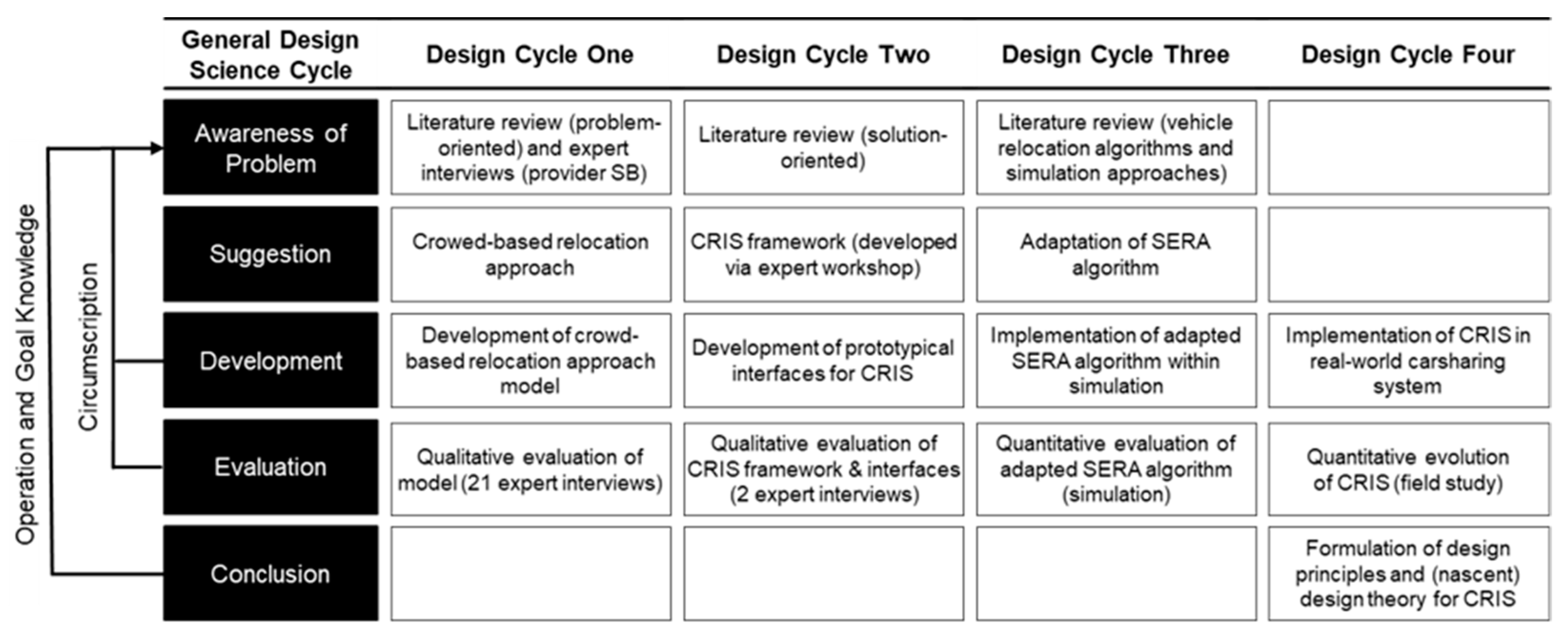

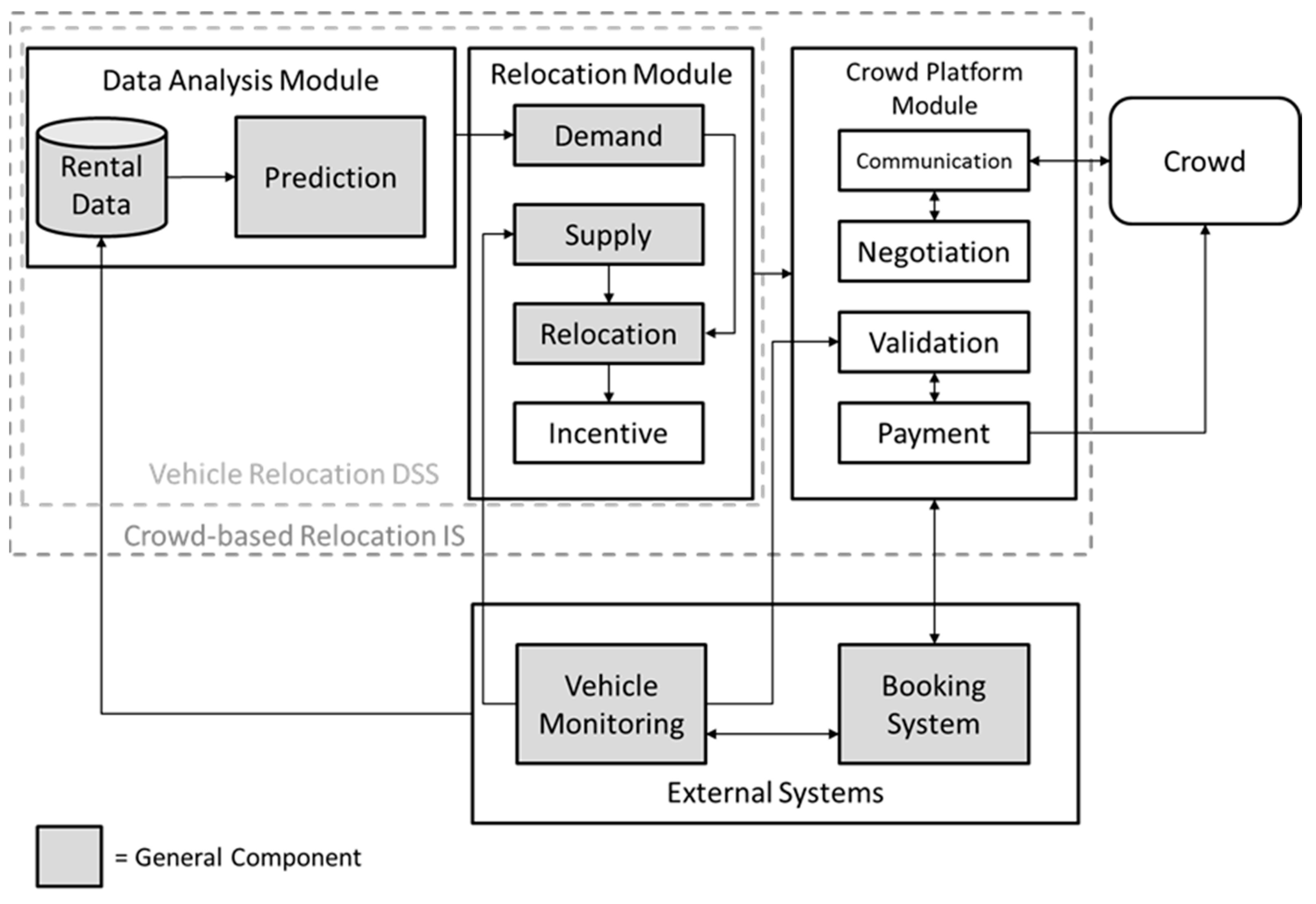

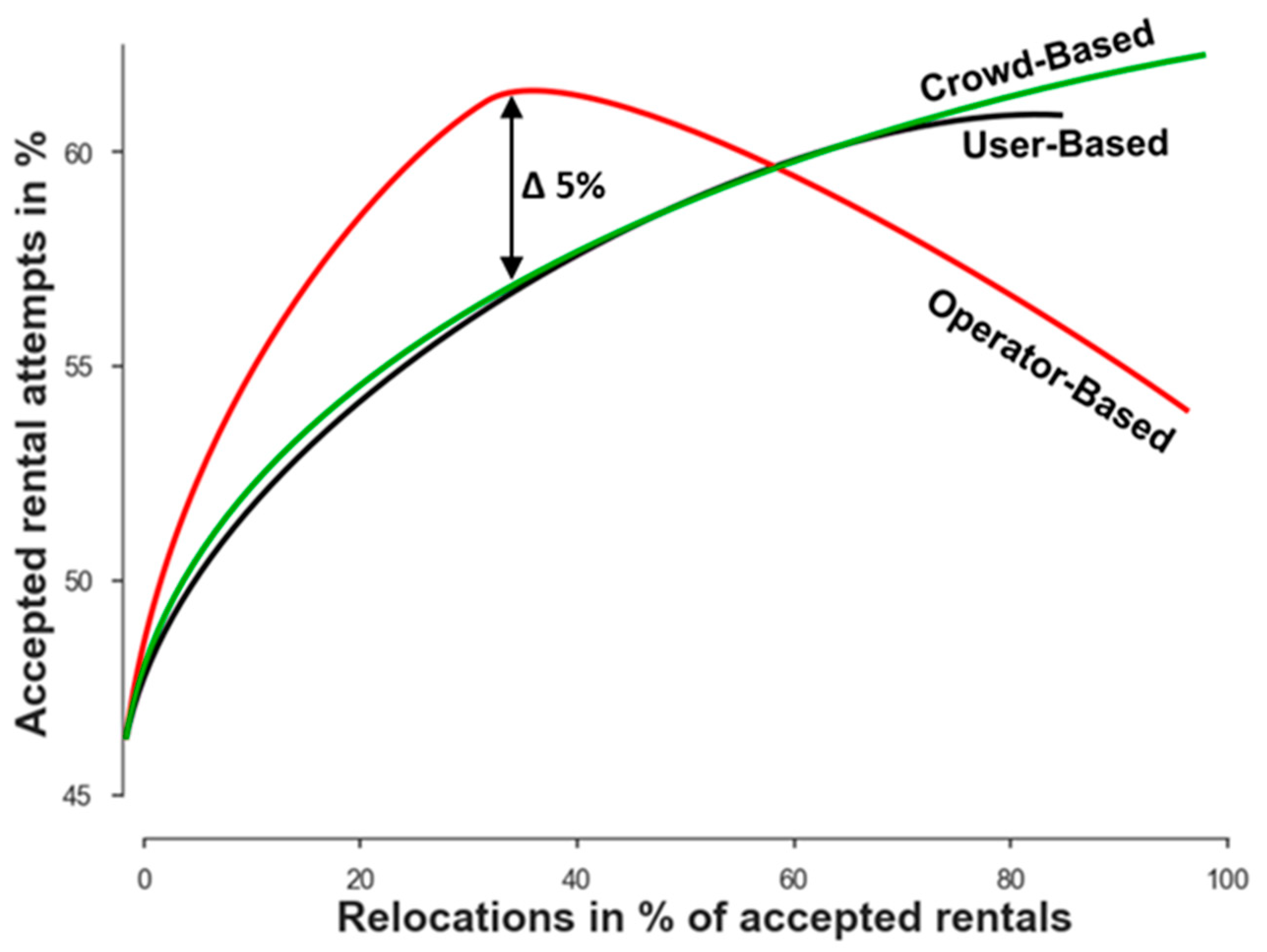

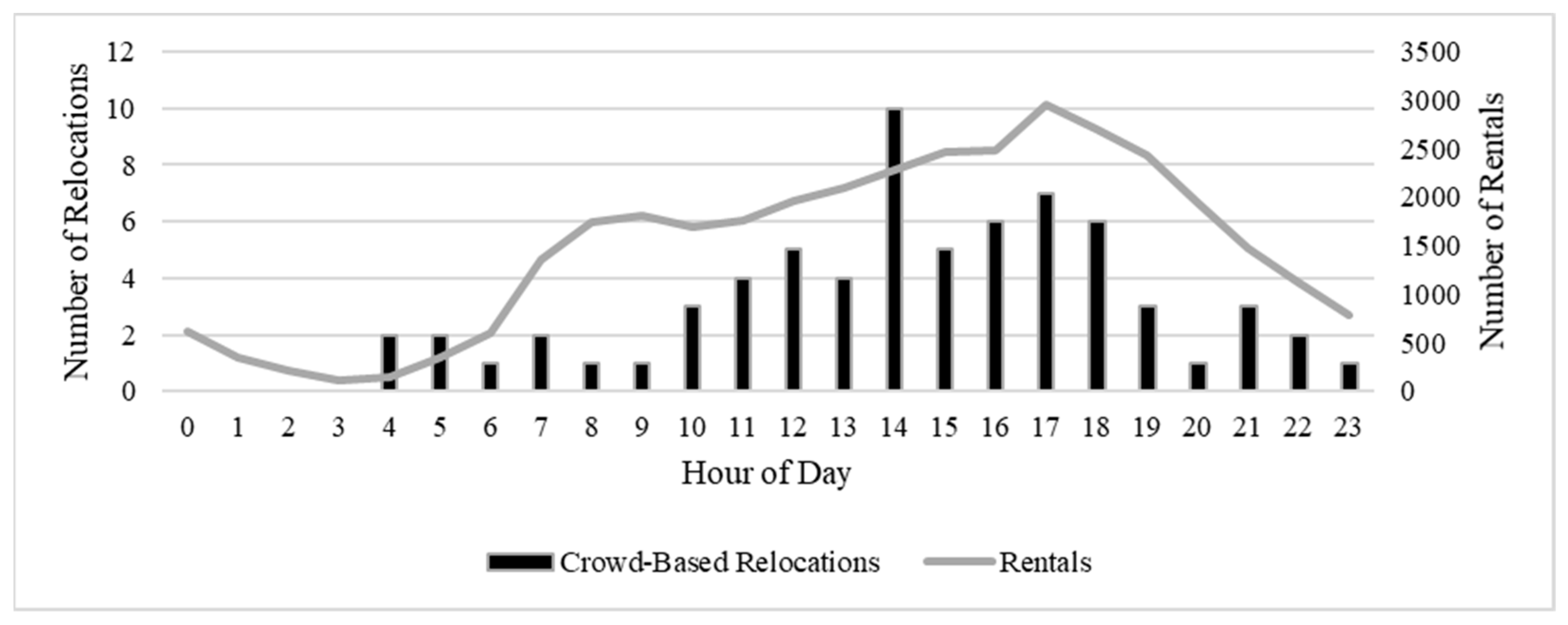
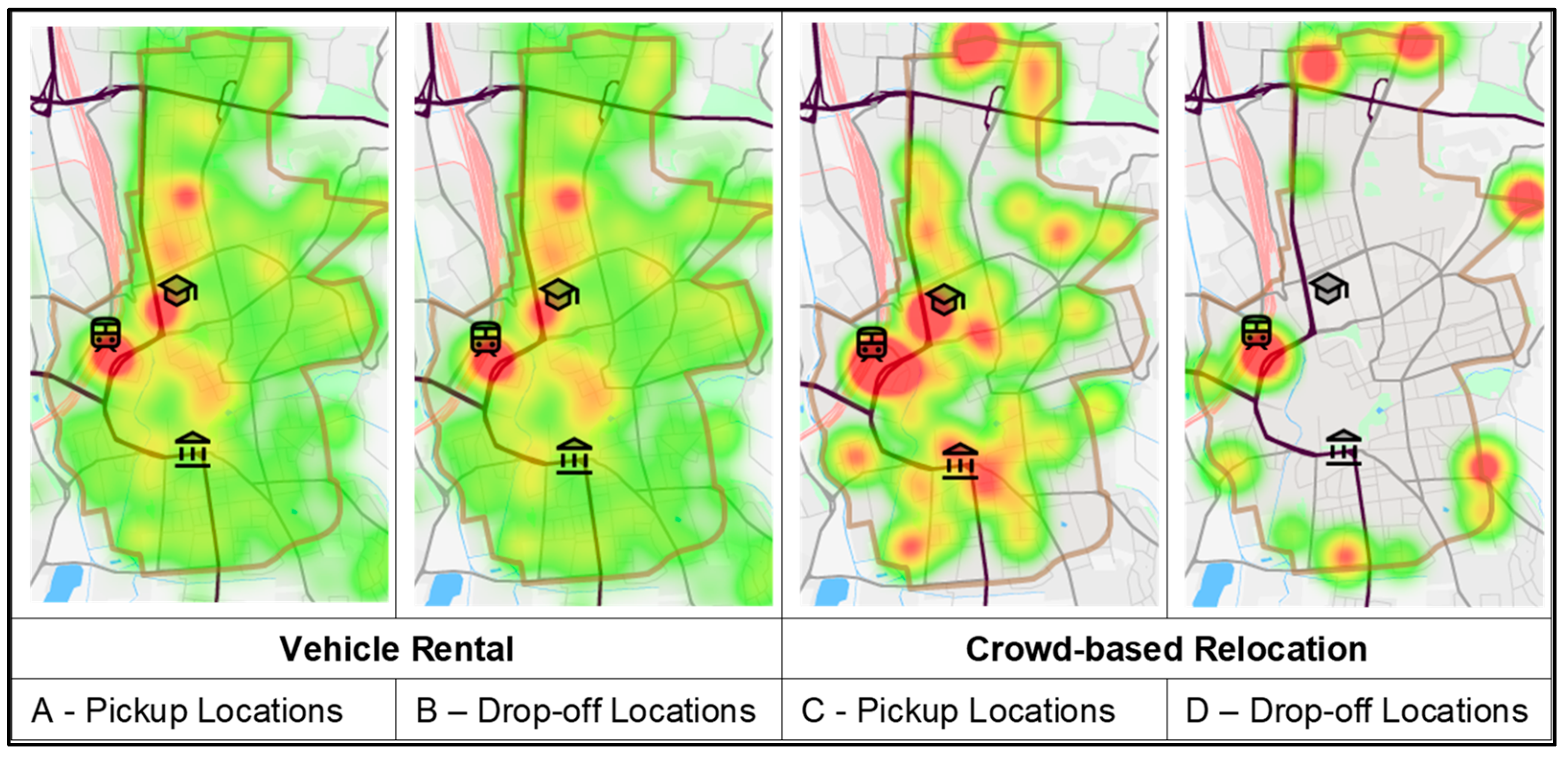
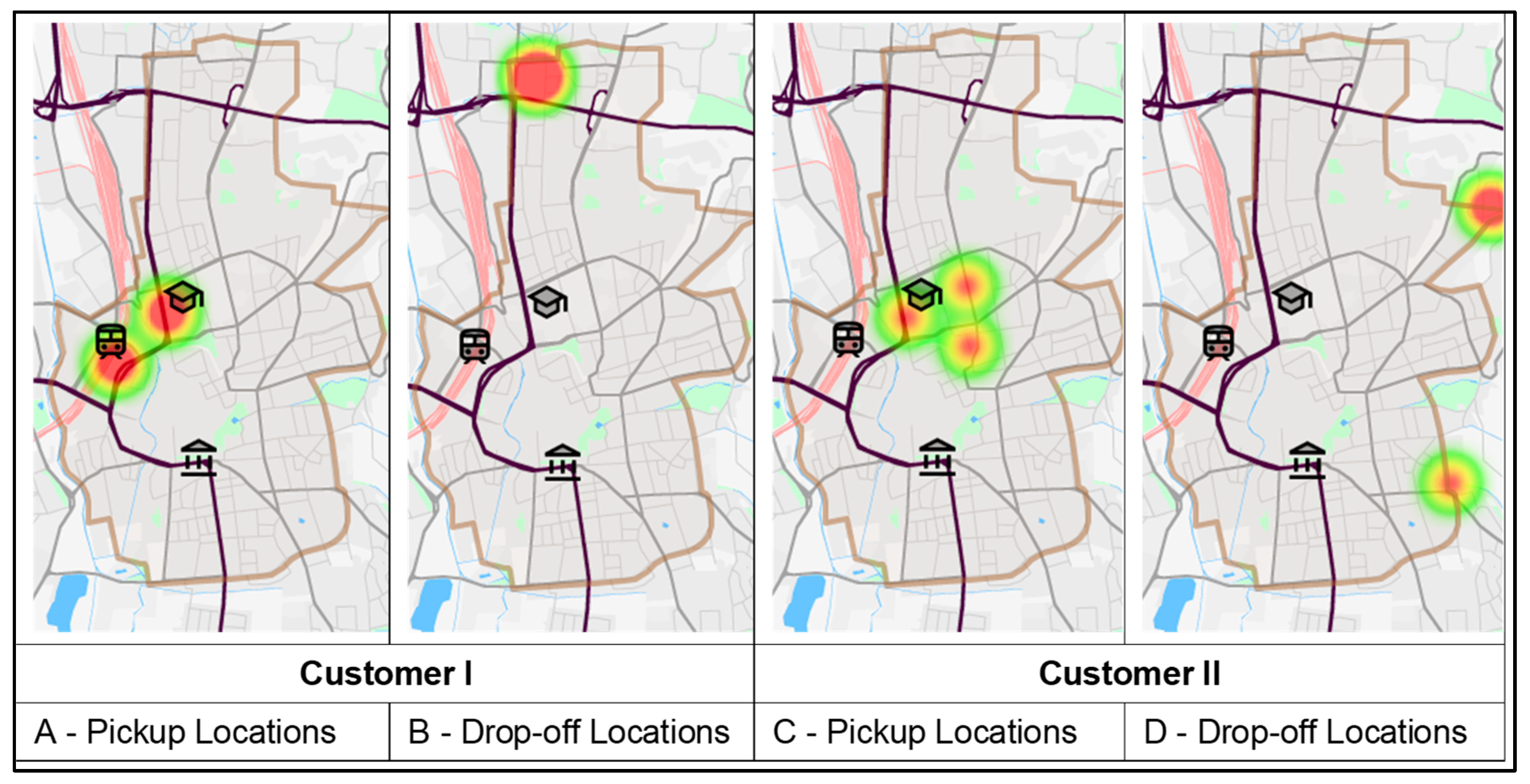
| No. | Approach | Modus | Rental | Relocator | Expenses | Examples |
|---|---|---|---|---|---|---|
| 1 | Operator-based | Reactive | Independently arranged | Operator | High | [43,45,46] |
| 2 | User-based | Proactive | Arranged during rental | User | Low | [11,19] |
| 3 | Pricing | Preventive | Arranged before rental | - | Low | [22,47,48] |
| No | Requirement | Description | References |
|---|---|---|---|
| Performance | |||
| R1 | Reduction | The approach should reduce the number of operator-based relocations. | [39] |
| R2 | Efficiency | The approach should reduce the costs and emissions of vehicle relocations. | [39,45] |
| R3 | Availability | The approach should increase the car-sharing provider’s vehicle availability. | [39] |
| Implementation | |||
| R4 | Implementable | The approach should be easier to implement than user-based relocation. | Provider SB |
| R5 | Automation | The decision process regarding the relocation of vehicles should be completely automatic. | Provider FF & SB |
| R6 | Inexpensive | The approach should be inexpensive for the car-sharing provider to implement (e.g., no expensive hardware). | [11] |
| Application | |||
| R7 | Understandable | The approach’s relocation procedure should be easy for customers to understand. | Provider FF & SB |
| No | Responses | |||||
|---|---|---|---|---|---|---|
| How satisfied are you with the availability of the vehicles? | 1 | 2 | 3 | 4 | 5 | |
| 9.7% | 38.8% | 37.2% | 11.2% | 3.1% | ||
| Would you re-park a vehicle for a credit or discount, even if your actual destination was a different one? | 32.2% No|67.8% Yes | |||||
| How high would the credit or discount have to be to get you to re-park a vehicle? | €1 | €2 | €3 | €4 | €5 | €6 |
| 1.2% | 4.2% | 15.5% | 10.9% | 42.2% | 26% | |
| Would you use a vehicle that is further away than the nearest one if you get a discount or credit for it? | 24.8% No|75.3% Yes | |||||
| How far would you be willing to walk to a vehicle which needs to be re-parked? | 0 m | 100 m | 200 m | 300 m | 400 m | 500 m |
| 10.9% | 2.7% | 5.0% | 9.7% | 6.2% | 39.5% | |
| 600 m | 700 m | 800 m | 900 m | 1000 m | - | |
| 7.0% | 4.7% | 3.5% | 0.8% | 10.9% | ||
| How far would you be willing to walk to your actual destination, after re-parking a vehicle? | 0 m | 100 m | 200 m | 300 m | 400 m | 500 m |
| 5.3% | 10.5% | 12.7% | 10.5% | 41.2% | 9.2% | |
| 600 m | 700 m | 800 m | 900 m | 1000 m | - | |
| 3.9% | 2.2% | 0.4% | 0.0% | 3.9% | ||
| Would you re-park a vehicle, even if you did not actually want to use car-sharing? | 51.6% No|48.4% Yes | |||||
| Phase 1 | Phase 2 | |||
|---|---|---|---|---|
| Case | Base-Case | Crowd-Based | Base-Case | Crowd-Based |
| Time frame | 12 December 2016–9 April 2017 | 12 December 2017–9 April 2018 | 10 April 2017–28 May 2017 | 10 April 2018–28 May 2018 |
| Number of Rentals | 8250 | 7600 | 3442 | 2984 |
| Active Customers | 724 | 799 | 545 | 593 |
| Number of ob Relocations | 165 | 0 | 83 | 0 |
| Number of cb Requests | - | 1591 | - | 1184 |
| Number of cb Expired | - | 1169 | - | 1047 |
| Number of cb Relocations | - | 50 | - | 12 |
| Emissions for Relocation (CO2) | 89,100 g | 10,800 g | 44,820 g | 2592 g |
| Costs of Relocation | €990 | €192 | €498 | €42.36 |
| Average Incentive | - | €3.88 | - | €3.54 |
| Distance driven | 67,137 km | 78,319 km | 31,499 km | 31,792 km |
| Duration of Rentals | 605,988 min | 780,551 min | 230,768 min | 290,820 min |
| Revenue of provider FF | €32,897 | €38,376 | €15,435 | €15,578 |
| Number of Rentals | 8250 | 7600 | 3442 | 2984 |
| Number of Workdays | 101 | 97 | 38 | 39 |
| Number of Holidays | 18 | 22 | 11 | 10 |
| Test Workdays/Holidays | 0.600 | 1.000 | ||
| Average Rentals per Workday | 7275 | 6689 | 7439 | 6313 |
| Average Rentals per Holiday | 5011 | 5055 | 5591 | 5220 |
| Hours with Rainfall | 689 | 556 | 128 | 94 |
| Hours without Rainfall | 2166 | 2299 | 1048 | 1082 |
| Test Hours with/without Rainfall | <0.001 *** | 0.020 ** | ||
| Average Temperature | 3.14 °C | 2.49 °C | 10.38 °C | 14.55 °C |
| Test Hourly Temperature | <0.001 *** | <0.001 *** | ||
| ||||
| ob = operator-based; cb = crowd-based; * = p < 0.05; ** = p < 0.01; *** = p < 0.001 | ||||
| ID | Adjustment | ∑ Total | ∑ Completed | ∑ Expired | Acceptance Ratio |
|---|---|---|---|---|---|
| 1 | No adjustment | 2278 | 62 | 2216 | 2.72% |
| Adjusted by request time | |||||
| 2 | Requests only during main service-hours (10 h–19 h) | 778 | 44 | 734 | 5.66% |
| Adjusted by pickup locations: | |||||
| 3 | Vehicle pickup in a radius of 200 m around points-of-interest (train station and university) | 234 | 20 | 214 | 8.55% |
| Adjusted by request time and pickup locations: | |||||
| 4 | 2 and 3 combined | 141 | 17 | 124 | 12.06% |
| No | Requirement | Description | Testable Propositions | Evaluation Result |
|---|---|---|---|---|
| Performance | ||||
| R1 | Reduction | The approach reduces the number of operator-based relocations. | TP1—When implementing R1, the resulting CRIS reduces the number of operator-based relocations required. | No operator-based relocation is required, while a similar level of revenue (e.g., €32,897 in phase 1 base case vs. €38,376 in the crowd-based system) is maintained. |
| R2 | Efficiency | The approach reduces costs and emissions of vehicle relocation. | TP2—When implementing R2, the resulting CRIS leads to lower costs and emissions than operator-based relocation does. | The cost of relocations reduced significantly (80.6% and 91.5%) as did the emission rates (94.2% and 91.5%). |
| R3 | Availability | The approach increases vehicle availability. | TP3—When implementing R3, the resulting CRIS leads to a higher number of vehicle relocations compared to the “no relocation” approach. TP4—When implementing R4, the resulting CRIS leads to a similar number of vehicle relocations compared to user-based and operator-based approaches. | The vehicles remained as available as in operator-based relocation. |
| Implementation | ||||
| R4 | Implementable | The approach is easier to implement than user-based relocation. | TP5—When implementing R4, the resulting CRIS can be successfully implemented. | Provider FF’s IT department attested to CRIS being easy to implement and integrate into the existing system. |
| R5 | Automation | The decision process is completely automatic. | TP6—When implementing R5, the resulting CRIS does not require the car-sharing provider to intervene in the relocation procedure. | Provider FF had no need to intervene during the field-study because all crowd-based relocations were requested and completed automatically. |
| R6 | Inexpensive | The approach does not lead to extra costs for the car-sharing provider. | TP7—When implementing R6, the resulting CRIS does not lead to high implementation or maintenance costs (e.g., for hardware or personnel). | Besides the implementation costs, applying crowd-based relocation did not lead to any additional costs. |
| Application | ||||
| R7 | Understandable | Customers can easily understand the approach. | TP8—When implementing R7, customers find the resulting CRIS easy to use. TP9—When implementing R7, the resulting CRIS allows multiple users to accept and complete a relocation task. | Provider FF did not report any notice of customers confused by crowd-based relocation. Relocation requests were accepted and completed by different customers. |
| Design Principle 1 | |
|---|---|
| Summary | Give the car-sharing provider the capability to outsource relocation tasks to its customers, to increase the car-sharing system’s overall efficiency, cost effectiveness, and environmental sustainability. |
| Aim, Implementer, and Users | Enable car-sharing providers to increase the efficiency, cost effectiveness, and environmental sustainability of their vehicle relocation operations. |
| Context | Car-sharing providers have the digital infrastructure to monitor vehicle rentals in real-time and to bill customers. Car-sharing providers do not have the capabilities to implement complex and intricate relocation systems.
|
| Mechanism | M1—Request customers to relocate vehicles. M2—Request all customers to relocate via an open relocation request. M3—Incentivize customers with credit or discounts that are below the cost of operator-based relocations. M4—Integrate the request communication functionalities into the car-sharing renting system. M5—Offer the highest incentive directly after issuing the relocation request. |
| Rationale | M1—Customers cost less than employees [11,24]. M2—All customers could perform a relocation, and requesting all customers ensures a bigger crowd than sending selective requests; widely sent calls increase the possibility of a customer answering to a relocation request [49]. M3—A single point of access reduces the risk of customers not noticing the requests. Further, it automatically restricts access to the system to customers, who are known to and validated by the provider, thus this is an effective crowd building process [49]. M4—Incentivizing customers with credit and discounts does not require participating customers to have permits and to be self-employed [68,69]. Also, customers expect a quick and easy rental process [9]. M5—The impact of a relocation on the overall vehicle availability decreases over time, as a result of the frequently changing vehicle distribution [71]. |
| Design Principle 2 | |
|---|---|
| Summary | Equip the car-sharing provider with the capability to automatically analyze current vehicle distribution and forecast future demand in order to determine required crowd-based relocations that increase vehicle availability. |
| Aim, Implementer, and Users | Allow car-sharing providers to identify necessary vehicle relocations, i.e., relocations that lead to an improved vehicle distribution, which will result in a higher number of vehicle rentals. |
| Context | Car-sharing providers have the digital infrastructure to monitor vehicle rentals in real-time and to bill customers. Car-sharing providers have to perform multiple relocations during a single day (R5).
|
| Mechanisms | M5—Include components for data analysis, relocation computation, and connections to the car-sharing provider’s rental system. M6—Apply a vehicle relocation algorithm (e.g., ALGO) to compute the necessary crowd-based relocations. In this process, the algorithm selects and requests relocations that originate and/or end at points-of-interest (e.g., train station, hospital, city center) and take place during main service hours (e.g., when customers regularly use the service). |
| Rationale | M5—The three identified components are required to compute a vehicle relocation. This design extends Wagner et al.’s [11] framework for user-based relocation. M6—Relocation has to be necessary; performing no relocations or unnecessary relocations are ineffective in attracting more vehicle rentals. Customers are less willing to perform relocations that do not fit their regular rental behavior regarding destination, origin, and rental time. |
Publisher’s Note: MDPI stays neutral with regard to jurisdictional claims in published maps and institutional affiliations. |
© 2022 by the authors. Licensee MDPI, Basel, Switzerland. This article is an open access article distributed under the terms and conditions of the Creative Commons Attribution (CC BY) license (https://creativecommons.org/licenses/by/4.0/).
Share and Cite
Brendel, A.B.; Lichtenberg, S.; Morana, S.; Prinz, C.; Hillmann, B.M. Designing a Crowd-Based Relocation System—The Case of Car-Sharing. Sustainability 2022, 14, 7090. https://doi.org/10.3390/su14127090
Brendel AB, Lichtenberg S, Morana S, Prinz C, Hillmann BM. Designing a Crowd-Based Relocation System—The Case of Car-Sharing. Sustainability. 2022; 14(12):7090. https://doi.org/10.3390/su14127090
Chicago/Turabian StyleBrendel, Alfred Benedikt, Sascha Lichtenberg, Stefan Morana, Christoph Prinz, and Boris M. Hillmann. 2022. "Designing a Crowd-Based Relocation System—The Case of Car-Sharing" Sustainability 14, no. 12: 7090. https://doi.org/10.3390/su14127090
APA StyleBrendel, A. B., Lichtenberg, S., Morana, S., Prinz, C., & Hillmann, B. M. (2022). Designing a Crowd-Based Relocation System—The Case of Car-Sharing. Sustainability, 14(12), 7090. https://doi.org/10.3390/su14127090






